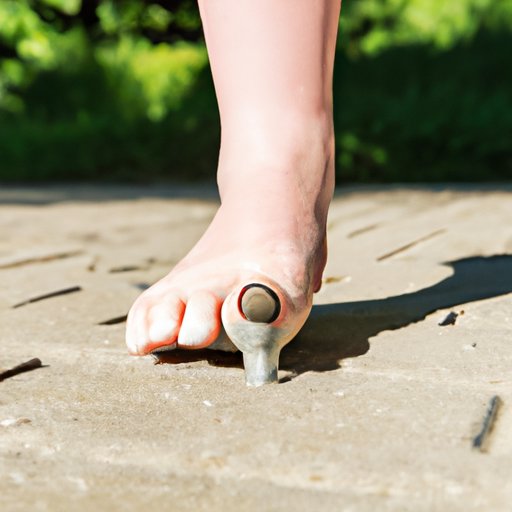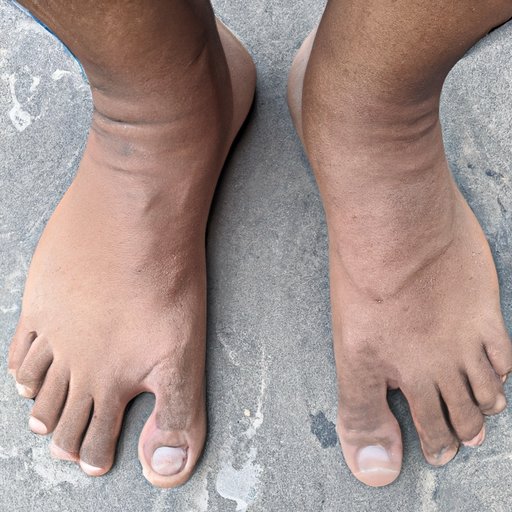
Introduction
Losing a body part, no matter how small, can greatly affect a person’s daily activities and quality of life. The big toe, though often overlooked, plays a crucial role in walking and maintaining balance. In this article, we will explore whether it is possible to walk without a big toe and the different factors that can affect a person’s mobility. We will also discuss alternative strategies, common injuries, and conditions that can lead to the loss of a big toe and the importance of seeking professional help and resources.
The Anatomy of the Big Toe and Its Role in Walking
The big toe, also known as the hallux, is the largest and most crucial toe for walking and maintaining balance. It consists of two small bones, the distal and proximal phalanges, connected by a joint that allows for flexion and extension. The toe is supported by a complex network of ligaments, tendons, and muscles, including the flexor hallucis longus and brevis, extensor hallucis longus and brevis, and the abductor hallucis.
During the walking cycle, the big toe plays a crucial role in propulsion and stability. As the foot rolls forward, the big toe provides a push-off force, helping to propel the body forward. It also helps to maintain balance by acting as a pivot point, providing stability and allowing for lateral movement.
Factors that can affect the big toe’s performance include age, foot structure, and footwear. As we age, the joints in our body undergo wear and tear, which can limit their range of motion and stability. Some people may also have a pre-existing foot structure, such as a bunion or hallux valgus, that can affect the positioning and function of the big toe. Wearing the wrong type of footwear, such as high heels or shoes with a narrow toe box, can also lead to the deformation of the big toe joint and affect its ability to function properly.
Alternatives to the Big Toe: Compensating for Its Loss
While walking without a big toe can be challenging, it is possible to compensate for its loss. One strategy is to distribute the weight across the other toes, particularly the second toe, which is also responsible for a significant portion of the push-off force during walking. This can be achieved by wearing shoes with a wider toe box to allow the toes to spread out naturally.
Exercises that focus on improving balance and stability can also help individuals compensate for the loss of their big toe. These include simple exercises such as standing on one foot or walking on uneven surfaces. Physical therapy and rehabilitation can also help individuals improve their gait and balance and prevent further injury.
Footwear also plays a critical role in walking without a big toe. Shoes with an elevated heel can help shift the weight forward and reduce the amount of pressure on the remaining toes. Custom orthotics or insoles can also be used to help redistribute the body weight and support the arch of the foot.
The Potential Long-Term Effects of Walking Without a Big Toe
Walking without a big toe can have long-term consequences on a person’s mobility and overall health. Without the big toe’s push-off force and stability, individuals may experience increased stress on their remaining toes and joints, leading to pain, swelling, and joint deformities. They may also be at a higher risk for falls and other injuries due to decreased balance and stability.
The loss of a big toe can also have psychological effects, including a sense of loss or decreased self-confidence. Seeking professional help and intervention early on can prevent further damage and improve a person’s overall quality of life.
How Toe Prosthetics Can Improve Mobility for Amputees
Toe prosthetics are a viable option for individuals who have lost their big toe due to injury or disease. These prosthetics can help individuals regain their gait and mobility and can be customized to fit each person’s specific needs and foot structure.
Advantages of toe prosthetics include improved balance and stability, reduced pressure on the remaining toes, and increased comfort. However, limitations include the need for maintenance and the potential for skin irritation or discomfort.
Successful stories of individuals using toe prosthetics can provide hope and inspiration for those facing the loss of their big toe. With the help of a medical professional, individuals can find the best prosthetic option that fits their unique needs and lifestyle.
Common Injuries and Conditions That Can Lead to the Loss of a Big Toe
Several injuries and conditions can lead to the loss of a big toe. These include trauma, such as a severe crush injury or a traumatic amputation, and disease, such as diabetic foot ulcers that lead to gangrene.
Risk factors for these injuries or conditions include poor foot hygiene, pre-existing foot structure abnormalities, and chronic diseases such as diabetes and peripheral artery disease. Prevention and treatment options include maintaining good foot hygiene, wearing proper footwear, and seeking early intervention for any foot injuries or conditions.
Expert Advice on Maintaining Balance and Stability Without a Big Toe
Expert advice on maintaining balance and stability without a big toe includes several tips and strategies. These include wearing supportive shoes with a wider toe box, using custom orthotics or insoles, and performing exercises that focus on improving balance and stability.
Physical therapy and rehabilitation can also help individuals improve their gait and balance and prevent further injury. Maintaining a healthy lifestyle, including a nutritious diet and regular exercise, can also improve overall foot health and reduce the risk of further injury or complications.

Success Stories of Individuals Who Have Adapted to Walking Without a Big Toe
Personal accounts of individuals who have successfully adapted to walking without a big toe can provide hope and inspiration for others facing a similar situation. These individuals may have faced unique challenges, such as modifying their gait or finding appropriate footwear, but have found ways to compensate for their loss and maintain their mobility.
Advice from these individuals includes seeking the help of medical professionals early on, maintaining a positive attitude, and finding the right support network. With perseverance and a willingness to adapt, individuals can lead a fulfilling and active life, even without a big toe.
Conclusion
In conclusion, while losing a big toe can greatly affect a person’s mobility and quality of life, there are different strategies and resources available to help individuals compensate for its loss. These include wearing proper footwear, performing exercises that focus on improving balance and stability, and seeking professional help and intervention early on. With the right mindset and support, individuals can successfully adapt and lead a fulfilling life, even without a big toe.





